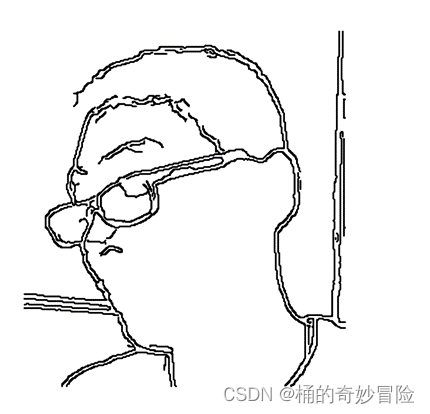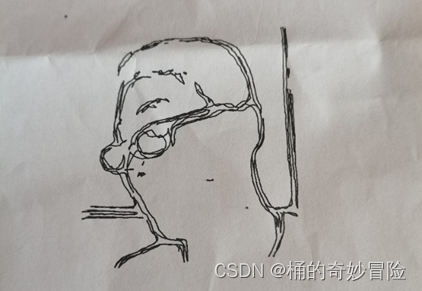实验器材
Dobot机械臂+笔+小型摄像头+电脑软件+白纸
项目描述
创意来源:
前段时间有个团队实现了通过手机拍照将照片传到机器中,机器实现画图。于是想着通过Dobot机械臂实现同样甚至更好的功能。
在实验指导书上看到,Dobot机械臂能够简单的进行写字,就联想到能够用它来画画,由摄像头实时拍摄对象,同时对显示的图像进行卡通化与素描化,展示较好的效果,最后输出图像到机械臂上,让机械臂作图。
实现功能:
1、通过python opencv包调用摄像头,实现摄像头的图像实现
2、对于每一帧的视频图像进行卡通化与素描化处理
3、通过键盘控制摄像头进行拍照并将照片保存
4、编写程序将图片从jpg格式转成svg(矢量图)格式,将转化出的矢量图导入dobot模块,控制机械臂绘图。

算法实现:
1、图片卡通化算法:
def cartoon(image):
gray = cv2.cvtColor(image, cv2.COLOR_BGR2GRAY)
gray = cv2.medianBlur(gray, 7)
edges = cv2.adaptiveThreshold(gray, 255, cv2.ADAPTIVE_THRESH_MEAN_C, cv2.THRESH_BINARY, 9, 10)
color = cv2.bilateralFilter(image, 12, 250, 250)
cartoon = cv2.bitwise_and(color, color, mask=edges)
return cartoon 2、图片素描化算法:
def sumiao(image):
cartoon_image1, cartoon_image2 = cv2.pencilSketch(image, sigma_s=60, sigma_r=0.15, shade_factor=0.05)
return cartoon_image1 3、图片格式转化算法:
def bitmap_to_contour_svg(input_bitmap_path: str, output_svg_path: str):
img = cv2.imread(input_bitmap_path)
dump_rings_from_image(img, output_path=output_svg_path)
remove_matplotlib_background(output_svg_path) 4、拍摄及主程序:
if cap.isOpened() is True: # 检查摄像头是否正常启动
while (True):
# 获取摄像头拍摄到的画面
ret, frame = cap.read()
img = frame
cartoon1=cartoon(img)
sumiao1=sumiao(img)
stylish1=stylish(img)
# 实时展示效果画面
# cv2.imshow('frame1', frame)
cv2.imshow('frame2',stylish1)
cv2.imshow('frame', sumiao1)
# 每5毫秒监听一次键盘动作
if cv2.waitKey(5) & 0xFF == ord('p'):
cv2.imwrite('pic_%d.jpg'%i,stylish1)
i += 1
bmp_to_svg.bitmap_to_contour_svg(input_bitmap_path="pic_0.jpg",
output_svg_path="pictuce_0.svg")
if cv2.waitKey(5) & 0xFF == ord('q'):
break
# 最后,关闭所有窗口
cap.release()
cv2.destroyAllWindows()
else:
print('cap is not opened!')
呈现效果



完整代码
import cv2
import bmp_to_svg
cap = cv2.VideoCapture(0)
i=0
def cartoon(image):
gray = cv2.cvtColor(image, cv2.COLOR_BGR2GRAY)
gray = cv2.medianBlur(gray, 7)
edges = cv2.adaptiveThreshold(gray, 255, cv2.ADAPTIVE_THRESH_MEAN_C, cv2.THRESH_BINARY, 9, 10)
color = cv2.bilateralFilter(image, 12, 250, 250)
cartoon = cv2.bitwise_and(color, color, mask=edges)
return cartoon
def sumiao(image):
cartoon_image1, cartoon_image2 = cv2.pencilSketch(image, sigma_s=60, sigma_r=0.15, shade_factor=0.05)
return cartoon_image1
def stylish(image):
# (风格化)
cartoon_image = cv2.stylization(image, sigma_s=150, sigma_r=0.45)
return cartoon_image
if cap.isOpened() is True: # 检查摄像头是否正常启动
while (True):
# 获取摄像头拍摄到的画面
ret, frame = cap.read()
img = frame
cartoon1=cartoon(img)
sumiao1=sumiao(img)
stylish1=stylish(img)
# 实时展示效果画面
# cv2.imshow('frame1', frame)
cv2.imshow('frame2',stylish1)
cv2.imshow('frame', sumiao1)
# 每5毫秒监听一次键盘动作
if cv2.waitKey(5) & 0xFF == ord('p'):
cv2.imwrite('pic_%d.jpg'%i,stylish1)
i += 1
bmp_to_svg.bitmap_to_contour_svg(input_bitmap_path="pic_0.jpg",
output_svg_path="pictuce_0.svg")
if cv2.waitKey(5) & 0xFF == ord('q'):
break
# 最后,关闭所有窗口
cap.release()
cv2.destroyAllWindows()
else:
print('cap is not opened!')bmp_to_svg.py文件
from typing import Iterable, List, Tuple, Union
import cv2
import matplotlib.pyplot as plt
import numpy as np
from xml.dom import minidom as md
from queue import Queue
import warnings
def look_shape(a: Iterable) -> Tuple:
# for debug
return np.array(a).shape
def length_within_points(a: Iterable, empty_value: Union[int, float] = 0) -> int:
"""
a simple instance:
array : [empty_value, empty_value, empty_value, 1, empty_value, 0, 1, 2, empty_value]
Then length_within_points(array) will return index diff between 1 and 2, which is 5
"""
a = list(a)
l_pivot, r_pivot = -1, -2
for index, (l_val, r_val) in enumerate(zip(a[::1], a[::-1])):
if l_val != empty_value and l_pivot == -1:
l_pivot = index
if r_val != empty_value and r_pivot == -2:
r_pivot = len(a) - index
return r_pivot - l_pivot + 1
def dump_rings_from_image(image: np.ndarray, output_path: str, plot_dict: dict = {"color": "k", "linewidth": 2.0},
default_height: float = 8) -> List[np.ndarray]:
# regular operation, no more explainations
blur = cv2.GaussianBlur(image, (3, 3), 0)
gray = cv2.cvtColor(blur, cv2.COLOR_BGR2GRAY)
edge = cv2.Canny(gray, 50, 150)
# get ratio between width and height to adjust the final output
valid_width = length_within_points(edge.sum(axis=0))
valid_height = length_within_points(edge.sum(axis=1))
true_ratio = valid_width / valid_height
# get contour of the edge image
contour_tuple = cv2.findContours(edge, mode=cv2.RETR_TREE, method=cv2.CHAIN_APPROX_NONE)
contours = contour_tuple[0]
rings = [np.array(c).reshape([-1, 2]) for c in contours]
# adjust coordinate system to the image coordinate system
max_x, max_y, min_x, min_y = 0, 0, 0, 0
for ring in rings:
max_x = max(max_x, ring.max(axis=0)[0])
max_y = max(max_y, ring.max(axis=0)[1])
min_x = max(min_x, ring.min(axis=0)[0])
min_y = max(min_y, ring.min(axis=0)[1])
# adjust ratio
plt.figure(figsize=[default_height * true_ratio, default_height])
# plot to the matplotlib
for _, ring in enumerate(rings):
close_ring = np.vstack((ring, ring[0]))
xx = close_ring[..., 0]
yy = max_y - close_ring[..., 1]
plt.plot(xx, yy, **plot_dict)
plt.axis("off")
plt.savefig(output_path)
def remove_matplotlib_background(svg_file: str, bg_node_name: str = "patch_1") -> None:
dom_tree: md.Document = md.parse(svg_file)
svg_node = None
# select the svg tag
for node in dom_tree.childNodes:
if node.nodeName == "svg":
svg_node: md.Element = node
if svg_node is None:
raise ValueError("not find a svg node in {}".format(svg_file))
# bfs svg node to find the background node
q = Queue()
q.put(svg_node)
target_node = None # we will remove the target node
while not q.empty():
cur: md.Node = q.get()
if cur.hasChildNodes():
for node in cur.childNodes:
q.put(node)
if hasattr(cur, "getAttribute"):
# this is the id of the background node
if cur.getAttribute("id") == bg_node_name:
target_node = cur
if target_node is None:
warnings.warn("background node is not found, please ensure whether bg_node_name is correct")
else: # remove and write
target_node.parentNode.removeChild(target_node)
with open(svg_file, "w", encoding="utf-8") as fp:
dom_tree.writexml(
writer=fp,
indent="\t"
)
def bitmap_to_contour_svg(input_bitmap_path: str, output_svg_path: str):
img = cv2.imread(input_bitmap_path)
dump_rings_from_image(img, output_path=output_svg_path)
remove_matplotlib_background(output_svg_path)
if __name__ == '__main__':
bitmap_to_contour_svg(
input_bitmap_path="pic_1_0.jpg",
output_svg_path="5.svg"
)
版权声明:本文为qq_50588811原创文章,遵循 CC 4.0 BY-SA 版权协议,转载请附上原文出处链接和本声明。